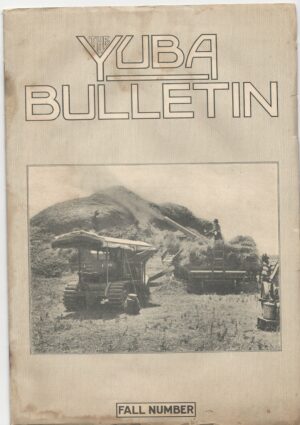Originally published as a blog for the Plymouth Historical Society on October 22nd, 2018.
It is hard to even fathom what construction and farming work must have been like over 100 years ago. As I write this, I can hear many construction vehicles reworking Fernbrook Lane right outside of Plymouth’s Old Town Hall, home to the Historical Society. One hundred years ago, similar projects likely would have required the use of horses. The mass use of large machinery was only in its infancy in the 1910s as highlighted by our object spotlight for this week: The Yuba Bulletin.
Based in California, the Yuba Construction Company began as a builder of gold dredges and dredge pumps to help the miners in the state’s gold fields. Because of inconsistent demand for production of the dredges and pumps, the company bought the rights to the Ball Tread Tractor. Ball Tread had the opposite problem of not having enough manufacturing facilities to keep up with the high demand for the tractor. To market this new acquisition, Yuba created a publication called The Yuba Bulletin. The Plymouth Historical Society has a copy of its first edition.

The Bulletin dates to the year 1915 which places it at the start of the tractor going mainstream. The Bulletin encourages readers to send in stories and pictures of how the tractors have helped their owners. The publication has copies of handwritten letters including a letter praising it for its help on the construction of the transcontinental telephone line and a riveting story of how two Yubas saved $140,000 of wheat in California by cutting off a fire’s path by plowing under a swatch of wheat. There is even a picture that shows where the tractors were assembled; Yuba did not utilize the moving assembly line that Ford Motor Company adopted in the 1910s.![]()

The Bulletin highlighted the incredible benefits of using the tractor, showing how one Yuba tractor could do the work of 22 horses and could replace the need for workhorses, representing a huge savings cost. The tractor could do things that horses could not including pulling through mud, working in the rain and at night, grading streets more quickly to aid water runoff, and working 24-hours a day. One of the company’s goals was to replace the need for horses completely.

To entice even more buyers, later editions of the Bulletin talked about a whole town celebrating getting its second tractor, the company not having enough materials to keep up with orders of tractors, and a warning to tractorless readers that they would be jealous of neighbors who had one. By 1917, only 4 years after Yuba sold its first Ball Tread, buying a tractor was no longer viewed as a gamble, but an investment.
There is little way to know how this Bulletin found its way into the Historical Society, but it does give an interesting perspective on the role of marketing in the early 1900s and the excitement that developed among farmers as they learned of these machines that were now cheap enough to replace their horses and completely change the way they farmed. It is not unlike the new technologies we see popping up all around us today that make things that were once necessities obsolete. The last Yuba tractor was produced in 1931.
